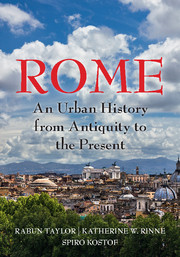Book contents
- Frontmatter
- Dedication
- Epigraph
- Contents
- List of Illustrations
- Acknowledgments
- Map
- INTRODUCTION
- 1 A BEND IN THE RIVER
- 2 A STORYBOOK BEGINNING
- 3 IDEOLOGICAL CROSSFIRE
- 4 BIG MEN ON THE CAMPUS
- 5 RES PUBLICA RESTITUTA
- 6 MEMORIALS IN MOTION: SPECTACLE IN THE CITY
- 7 THE CONCRETE STYLE
- 8 REMAKING ROME'S PUBLIC CORE: I
- 9 REMAKING ROME'S PUBLIC CORE: II
- 10 CRISIS AND CONTINUITY
- 11 RUS IN URBE: A GARDEN CITY
- 12 ADMINISTRATION, INFRASTRUCTURE, AND DISPOSAL OF THE DEAD
- 13 MAPPING, ZONING, AND SEQUESTRATION
- 14 TETRARCHIC AND CONSTANTINIAN ROME
- 15 TROPHIES AND TITULI: CHRISTIAN INFRASTRUCTURE BEFORE CONSTANTINE
- 16 WALLS MAKE CHRISTIANS: FROM FOURTH TO FIFTH CENTURY
- 17 A TALE OF TWO ROMES
- 18 THE ROME OF GOTHS AND BYZANTINES
- 19 CHRISTIAN FOUNDATIONS
- 20 FROM DOMUS LATERANI TO ROMANUM PALATIUM
- 21 THE LEONINE CITY: ST. PETER'S AND THE BORGO
- 22 VIA PAPALIS, THE CHRISTIAN DECUMANUS
- 23 THE URBAN THEATERS OF IMPERIUM AND SPQR
- 24 HOUSING DAILY LIFE
- 25 CHAOS IN THE FORTIFIED CITY
- 26 THE TIBER RIVER
- 27 HUMANIST ROME, ABSOLUTIST ROME (1420–1527)
- 28 PLANNING COUNTER REFORMATION ROME
- 29 PROCESSIONS AND POPULATIONS
- 30 MAGNIFICENT PALACES AND RHETORICAL CHURCHES
- 31 NEOCLASSICAL ROME
- 32 PICTURING ROME
- 33 REVOLUTION AND RISORGIMENTO
- 34 ITALIAN NATIONALISM AND ROMANITÀ
- 35 A CITY TURNED INSIDE OUT
- Glossary of Persons, Places, and Terms
- Works Cited
- Index
21 - THE LEONINE CITY: ST. PETER'S AND THE BORGO
Published online by Cambridge University Press: 05 July 2016
- Frontmatter
- Dedication
- Epigraph
- Contents
- List of Illustrations
- Acknowledgments
- Map
- INTRODUCTION
- 1 A BEND IN THE RIVER
- 2 A STORYBOOK BEGINNING
- 3 IDEOLOGICAL CROSSFIRE
- 4 BIG MEN ON THE CAMPUS
- 5 RES PUBLICA RESTITUTA
- 6 MEMORIALS IN MOTION: SPECTACLE IN THE CITY
- 7 THE CONCRETE STYLE
- 8 REMAKING ROME'S PUBLIC CORE: I
- 9 REMAKING ROME'S PUBLIC CORE: II
- 10 CRISIS AND CONTINUITY
- 11 RUS IN URBE: A GARDEN CITY
- 12 ADMINISTRATION, INFRASTRUCTURE, AND DISPOSAL OF THE DEAD
- 13 MAPPING, ZONING, AND SEQUESTRATION
- 14 TETRARCHIC AND CONSTANTINIAN ROME
- 15 TROPHIES AND TITULI: CHRISTIAN INFRASTRUCTURE BEFORE CONSTANTINE
- 16 WALLS MAKE CHRISTIANS: FROM FOURTH TO FIFTH CENTURY
- 17 A TALE OF TWO ROMES
- 18 THE ROME OF GOTHS AND BYZANTINES
- 19 CHRISTIAN FOUNDATIONS
- 20 FROM DOMUS LATERANI TO ROMANUM PALATIUM
- 21 THE LEONINE CITY: ST. PETER'S AND THE BORGO
- 22 VIA PAPALIS, THE CHRISTIAN DECUMANUS
- 23 THE URBAN THEATERS OF IMPERIUM AND SPQR
- 24 HOUSING DAILY LIFE
- 25 CHAOS IN THE FORTIFIED CITY
- 26 THE TIBER RIVER
- 27 HUMANIST ROME, ABSOLUTIST ROME (1420–1527)
- 28 PLANNING COUNTER REFORMATION ROME
- 29 PROCESSIONS AND POPULATIONS
- 30 MAGNIFICENT PALACES AND RHETORICAL CHURCHES
- 31 NEOCLASSICAL ROME
- 32 PICTURING ROME
- 33 REVOLUTION AND RISORGIMENTO
- 34 ITALIAN NATIONALISM AND ROMANITÀ
- 35 A CITY TURNED INSIDE OUT
- Glossary of Persons, Places, and Terms
- Works Cited
- Index
Summary
THE BUILT ENVIRONMENT AND NATURAL TOPOGRAPHY OF ST. PETER'S HAVE changed dramatically since the medieval period. There is little left of the grand and ragged splendor of Constantine's basilica, though it survived the vicissitudes of a millennium and more. Nor is much left of the great pilgrimage quarter with the hostels, monasteries, national scholae, the old papal palace, small churches, and diaconiae that crowded the medieval Vatican quarter, known as the Borgo, around St. Peter's basilica. Relics of its physical form are sprinkled in unlikely places: the giant pinecone and peacocks that adorned the central fountain of the atrium now ornament Bramante's Belvedere in the palace grounds. The obelisk, a surviving fixture of Nero's circus, long remained in situ on the south flank of the basilica transept; now it centers Bernini's oval Piazza S. Pietro. Of the other familiar medieval landmarks, only the indestructible Mausoleum of Hadrian is still there (see Fig. 65), demilitarized into a museum and pleasure gardens, and connected to the Borgo by fragments of the Leonine Wall, like some defanged but noble beast on a leash (Fig. 130). Yet despite all the changes, a pilgrim transported from the Middle Ages would have no problem recognizing the pervasive cult of St. Peter and his shrine, the foremost, if not the only, reason for the long, involved development and life of an entire urban region. Few manmade places in the world have more obsessively clung to the sustaining principles of a place of veneration in perpetuity.
To envision the medieval city at the Vatican, the Burgus Sancti Petri, or the Civitas Leonina of the documents, we must do several things: situate Constantine's church in the context of the built and natural environment of antiquity and its subsequent crowning with a string of dependent buildings; examine the development of the Vatican Palace before it was submerged under Renaissance forms; and unearth the urban history of the Borgo itself.
The Vatican and the Lateran were medievalized in distinct ways. For one thing, even if parts of the Vatican were developed under Caligula and Nero and were included in the regionary catalogs, the district retained a suburban character. The emperor Aurelian felt no need to enclose any part of it when he speedily threw up his wall around the city.
- Type
- Chapter
- Information
- RomeAn Urban History from Antiquity to the Present, pp. 196 - 204Publisher: Cambridge University PressPrint publication year: 2016



